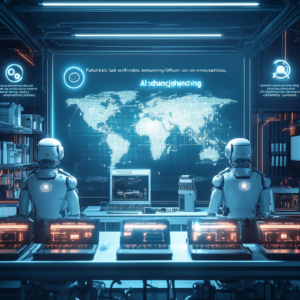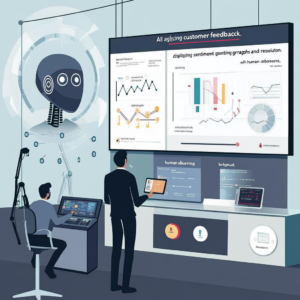
AI Agents: The Silent Revolutionaries Redefining Enterprise Software and Human Collaboration
The AI Agents: Pioneers of Perpetual Progress in Enterprise Software
Picture for a moment: a world where your software isn’t just sitting there, waiting for a click, but instead, it’s a savvy partner that’s one step ahead of you. A partner that solves problems, predicts needs, and evolves right alongside your business strategy. Welcome to the unfolding saga of AI agents, your digital colleagues, who aren’t just automating but revolutionizing how humans and technology connect. These little marvels of code are turning conventional enterprise software from a stifled bureaucratic apparatus to a living, pulsating ecosystem of intelligence and innovation!
Understanding Our New AI Colleagues
So, what on Earth is an AI agent? Simply put, they’re autonomous programs that not only observe their environment but also plan actions and act when necessary—often with minimal human intervention. They don’t just answer questions or follow command prompts; they’re digital workhorses that harness the power of large language models (LLMs), APIs, and keen decision-making algorithms to engage with tasks across various contexts. Take a business’s customer service desk, for example. An AI agent could analyze past customer interactions, pull relevant data from CRM systems, and resolve inquiries without breaking a sweat, all the while learning and adapting its strategies on the fly[1][3].
At the heart of it all? A slick little operational loop known as the observe-plan-act cycle:
- Observe: Watch the data streams, user inputs, and environmental changes like a hawk.
- Plan: Break down complex tasks into bite-sized actions using those fancy LLMs.
- Act: Execute those actions by reaching out through APIs or conversing with other agents.
Let’s not forget Lenovo’s shining example: they’ve seen code production improve by an impressive 10-15% and let 70-80% of customer interactions play out without human involvement thanks to their AI agents[2]. Not too shabby, right?
The Evolution of Enterprise Software
AI agents are flipping the script on how enterprise software operates. Here are three pivotal changes we can’t ignore:
1. Shifting from Automation to Genuine Autonomy
Boxed automation tools adhere to their pre-set scripts, but we live in an age of adaptation and innovation. AI agents breathe life into software—they make calculated decisions rather than just ticking boxes. Imagine marketing AI agents analyzing campaign metrics, tweaking budgets as needed, and even chatting up vendors in natural language like a seasoned negotiator[3]. This audacity transforms tools from being mere appendages to becoming proactive partners in the business venture.
2. Crafting a Human-AI Symbiosis
Now, let’s squelch that nagging myth: AI agents aren’t here to steal your job; they’re here to bolster human expertise. Picture a sales rapper teaming up with an AI wingman that dishes out real-time insights while drafting emails and forecasting customer pushbacks. This ain’t about replacing folks; it’s about amplifying our human powers. McKinsey projects that generative AI could usher in a staggering $2.6-4.4 trillion in annual value by automating workflows and enhancing decision-making[2][5].
3. Dynamic Software Ecosystems Are Here
Enterprise software is morphing into a world of modular, agent-driven platforms. Tools like Microsoft Copilot Studio and Salesforce Agentforce empower businesses to create bespoke agents that weave seamlessly into their existing setups. Forget the days of silos—these agents are engaging with one another and collaborating with human users, fostering a vibrant ecosystem of partnership[4]. Envision a supply chain agent netting its logistics buddies to optimize delivery routes like a well-rehearsed ballet!
The Roadblocks to Agent Adoption
But hold on a minute! It’s not all smooth sailing on this digital highway. Enterprises encounter a few bumpy patches:
- Data Governance: AI agents need clean, structured data to operate effectively. Messy data? Well, that’s a recipe for biased decisions and errors[1][4].
- Security Threats: These independent agents handling sensitive information require robust security measures, including tight access controls and encryption, lest disaster strikes[4].
- Trust Issues: Employees can be understandably resistant to AI agents, perceiving them as threats instead of comrades in arms[2].
Successful integration hinges on establishing clear governance frameworks, conducting thorough training, and maintaining an open dialogue about the roles of agents in the workplace[1][5].
Envisioning a Future of Work: Teams of Humans and AI
As AI agents continue to become more competent and widespread, we’ll witness a transformation in job dynamics. Instead of armies of analysts hunched over keyboards, companies will build sleek human teams backed by a legion of specialized AI agents. These agents will take over monotonous tasks, liberating human minds for strategic maneuvering. Imagine a marketing dream team with one leading strategist, and a battalion of AI agents managing campaigns, analytics, and customer engagement[3][5].
The World Economic Forum has made an audacious prediction: by 2027, half of the companies embracing GenAI will deploy these smart agents for everything from self-sufficient software engineering to dynamic supply chain optimizations[5]. Just think about it: a world where your enterprise software will not just be a tool, but a savvy ally ready to evolve with your demands, foreseeing challenges and presenting solutions before you even utter a word.
So there you have it! The rise of AI agents is not just a footnote in the corporate narrative; it’s a profound chapter reshaping the landscape of enterprise software and human collaboration. Curious to ride the wave of this transformative tech? Subscribe for more revelations and updates!

